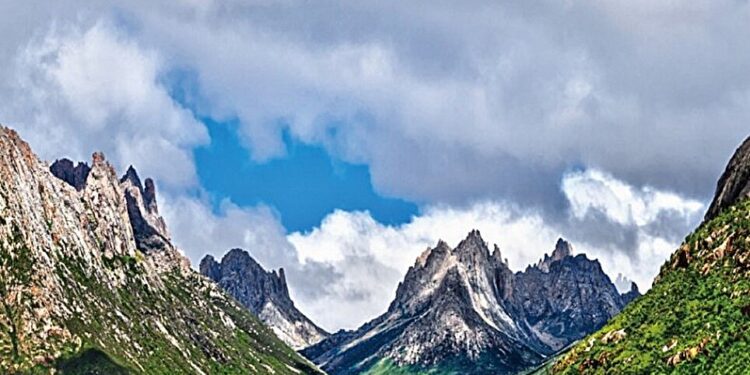The cover of the journal Advances in Atmospheric Sciences. Credit: USTC, Yunfei Fu.
Like many natural phenomena, precipitation can be both a blessing and a curse to human life. On the one hand, it supplies our rivers and fields with water; on the other, it can cause floods, landslides, and other natural disasters. In all cases, understanding and predicting the different types of precipitation is essential.
Collecting and analyzing precipitation data is essential, but there are places on Earth where it is tricky. One such place is the Tibetan Plateau, whose unique and challenging physical environment makes observing precipitation, either on the ground or from the sky via satellites, problematic.
In terms of satellite-based precipitation radar, the high altitude of the Tibetan Plateau leads to cases of misidentification of specific precipitation types. In particular, since the terrain height on the plateau is close to the freezing level height in the atmosphere above off-plateau areas, weak convective precipitation may be misclassified as stratiform precipitation.
Recognizing this, in a recent study published in Advances in atmospheric sciencesProfessor Fu Yunfei from the University of Science and Technology of China (USTC), together with colleagues from the China Meteorological Administration, first analyzed in detail the problems with the existing precipitation type identification algorithm for satellite-based precipitation radars, found out the reasons why the algorithm may fail in identifying precipitation types on the Tibetan Plateau in summer, and then developed and tested a new algorithm.
“It often seems like we want to standardize everything in the natural world, while ignoring the obvious complexities and diversities that exist at different scales,” Fu says. “In our field of science, meteorology, this is also true; and for the specific problem we are trying to solve in this study, the thresholds used to identify precipitation types are a specific example.”
Traditionally, based on observations in off-shelf regions, the approach to classifying precipitation is simplistic, resulting in a somewhat binary outcome where precipitation is identified as convective or stratiform.
With the new algorithm developed by Fu’s team, parameters such as maximum reflectance, maximum background reflectance, and echo top height are taken into account in greater depth to produce a more granular classification (types include “strong convective,” “weak convective,” “weak,” and “other”) that provides more useful information with much less misidentification.
Ultimately, Fu and his team’s work can be continued and adopted by the weather forecasting and modeling community to better predict the occurrence of different types of precipitation events in regions of the world where existing standardized methods are less applicable. More specifically, as the context of this particular paper highlights, communities living in mountainous regions such as the Tibetan Plateau can benefit greatly.
“However, it must be acknowledged that much work remains to be done,” Fu concludes. “In particular, we need to confirm the existence of stratiform precipitation on the Tibetan Plateau in summer. For various reasons, this precipitation is still difficult to detect using satellite precipitation radar measurements. This will be the next step in our research.”
The document is featured on the cover of the issue Advances in atmospheric sciencesThe cover photo was taken by Fu in the Lianbao-Yeze Nature Reserve located at the junction of Xichuan, Gansu and Qinghai provinces, at an average altitude of more than 4,000 meters above sea level. It shows convective clouds above the lake in the foreground, as well as above the tip of the mountain in the center.
More information:
Yunfei Fu et al., A new rainfall type classification algorithm for GPM dual-frequency precipitation radar on the Tibetan Plateau in summer, Advances in atmospheric sciences (2024). DOI: 10.1007/s00376-024-3384-7
Provided by University of Science and Technology of China
Quote: New algorithm corrects misclassification of precipitation types on the Tibetan Plateau (September 16, 2024) retrieved September 17, 2024 from
This document is subject to copyright. Apart from any fair dealing for the purpose of private study or research, no part may be reproduced without written permission. The content is provided for informational purposes only.



